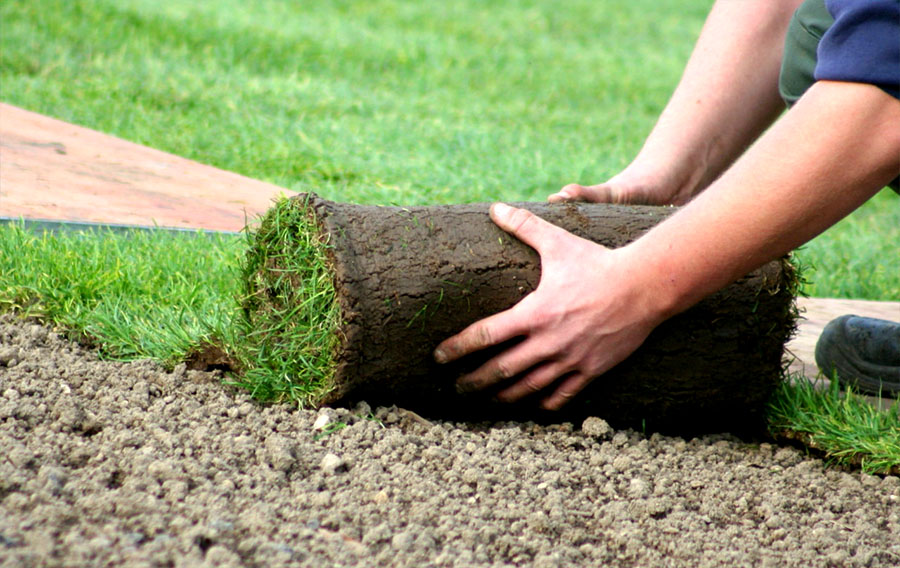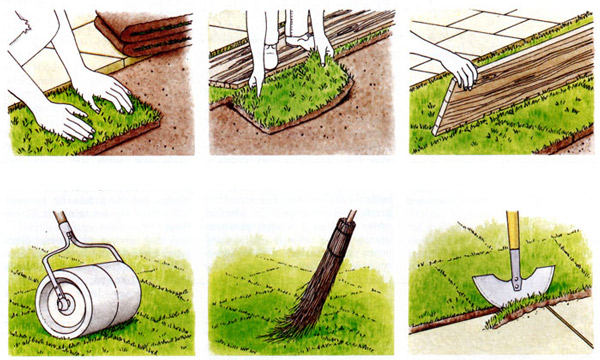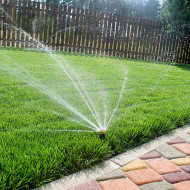Grass all year round: how to choose and care for a rolled lawn
Content
Benefits of a roll lawn
The simplest way to improve the area is considered to be the use of lawn grass. There are two types of lawns: seeded and rolled. The first option is considered cheaper and more durable. However, caring for a sowing lawn is a huge physical and time-consuming task. Beautiful and neat grass on the front lawn will not appear in a matter of days. First you need to sow the seeds, wait for the shoots and constantly monitor the appearance of the vegetation.

Unlike seeded, rolled lawn is grown in advance in the fields and supplied to the consumer in the form of a carpet of juicy greenery. What is a roll lawn? This is a dense layer of sod land with grass sprouted on it. The main advantages of using a lush green carpet are:
- Ease of operation and the ability to use on embossed surfaces.
- Unpretentiousness to growing conditions. Active solar lighting poses no danger to the grass. On the contrary, the sun's rays add juiciness and brightness to the vegetation.
- Minimization of time and physical costs of care. Lack of active growth of weeds and other unwanted vegetation.
- High resistance to drought, frost and sudden changes in temperature conditions.
- Persistent immunity to most diseases of the herb of fungal, bacterial and viral nature.
- Possibility of partial "repair" and replacement of a leaky or damaged part.
Roll lawn is presented in a wide range. The attention of consumers is offered a universal, shady, sports and parterre lawn, as well as a ready-made grass cover for golf courses.
The main cons
The main disadvantage of the finished grass cover is the high cost of a turnkey lawn. For example, the cost of a turnkey sowing lawn will be 2-3 times less. If your choice is based on quality, it is still better to give preference to the roll option.
When choosing a ready-made grass covering, there is a high risk of buying low-quality material. To reduce the cost of manufacturing goods, unscrupulous manufacturers and suppliers use expired or low-quality material. It is possible to identify a fake visually: the presence of bald spots and irregularities indicates the low quality of the grass cover.
Another drawback is the heavy weight. It is practically impossible to carry out styling on your own. It is necessary to have assistants or specialists in installation, which entails additional costs.

How to choose and check the quality
Having dealt with the advantages and disadvantages of the finished grass cover, let's move on to choosing it. After all, the final result depends on the correctness of the choice made.
The composition of the turf depends on its intended use.The shade-tolerant "variety" consists of fescue (80%) and bluegrass (20%), the sports variety consists of meadow bluegrass (50%), red fescue (25%) and ryegrass (25%). The versatile green carpet includes 60% bluegrass, 30% fescue and only 10% ryegrass.
The seams have a standard size - 200x40 cm. The average weight of one bay is about 25 kg.
The height of grass stalks can vary from 2 to 7 cm. The optimal value is 3 cm. When choosing a lawn, pay attention to its uniformity. Carelessly trimmed grass, the presence of dents, yellowness and bald spots are the main signs of low-quality material. The total area of errors per layer should not exceed 10 cm². The density of the grass is about 50 stems per 10 cm².
The next selection criterion is the color of the grass. The vegetation should have a fresh, rich green color. Stale goods have a dark shade and an unpleasant musty odor. Don't buy stale material. The likelihood that the grass will not take root is too high.
Be sure to carefully examine the sod, because the further growth of vegetation depends on the quality of the soil used. The optimum sod thickness is 2–2.5 cm. The number of viewed roots is at least 50%. The roots should be light and dense.
When trying to pinch off a piece of lawn, the turf retains the density and integrity of the structure. Otherwise, the "green carpet" will crumble during transport or installation.

Is it possible to grow a roll lawn yourself
Many are interested in whether it is possible to grow a roll lawn at home. Since the process of making a turf requires certain knowledge and skills, not everyone can cope with such a task. In the process, the following difficulties may arise:
- selection of the optimal composition of the grass mixture;
- soil preparation taking into account the required acidity level;
- calculation of nutrients necessary for vegetation in the turf;
- uniform sowing of seeds;
- germination quality control;
- lawn care.
Self-production of a roll lawn is a laborious and time-consuming process. The expediency of such a decision is highly questionable.
Video "Secrets of Laying Roll Lawns"
This video clearly demonstrates all the stages of laying the finished grass cover.
Soil preparation
The territory is preliminarily cleared of debris, solid objects and various vegetation, including weeds.
The plots located in lowland areas are equipped with a drainage system. First, remove the top layer (about 40 cm) of fertile soil. Then a gravel-sand cushion is poured (10 cm of gravel and 10 cm of sand). In some cases, the sand is replaced with geotextile fabric. The drainage is carefully compacted and fertile soil is covered. The ground is carefully leveled and re-tamped.
The need for arranging a drainage system is assessed by a specialist when examining the site. Accordingly, the prices for installation may vary significantly. So, the minimum cost of a turnkey lawn is from $ 5 / sq. m.
Lawn laying
Do not rush to make a purchase of material. First, they prepare the site and the soil, then buy and lay a "green carpet". Laying is done in one go. If you break the process over several days, the likelihood of uneven acceptance of the grass increases. The turf will look patchy and too artificial.
The roll starts from the place of its temporary storage. Therefore, the site is initially marked and each bay is moved to its place.
It is not recommended to move the layers of the rolled lawn frequently. Such manipulations can lead to shedding of the sod and the appearance of bald spots.
For a snug fit, the layers are laid in a checkerboard pattern. The edges of the canvases, marking the boundaries of the plot, are carefully cut off with a shovel or a sharp garden knife.The gap between the canvases should be minimal - no more than 15 mm.
Since fresh grass is easily deformable, you cannot walk on it. Moving on the laid "green carpet" is possible only on platforms made of planks.
At the end of the laying, the lawn is watered and shrunk. For this you need a special ice rink. It is better not to walk on the lawn for the first few days.

How to care
At the end of today's article, we will tell you about the basic rules for caring for a rolled lawn.
For the first two weeks, the grassy cover is constantly sprayed, preventing the sod from drying out. In the future, the interval between watering increases: one humidification is enough for 10-12 days. Walking on wet grass is prohibited!
After a month, you can perform the first haircut. Gasoline and electric trimmers and lawn mowers are used to improve the green cover.
Before the cold weather, the grass is allowed to germinate 4–6 cm in height. Such a height of the vegetation cover will allow the rolled lawn to overwinter without negative consequences. In the spring, when the snow melts, the "green carpet" is dried. To remove excess moisture, several punctures of the turf should be made around the perimeter of the site.
- Watering
- Mowing with a lawn mower
- Snow and moisture removal
In order for the rolled lawn to quickly take root, it is laid in spring or autumn. Since the procedure is not easy, it is better to use the services of specialists who will perform all the work as quickly and efficiently as possible.



